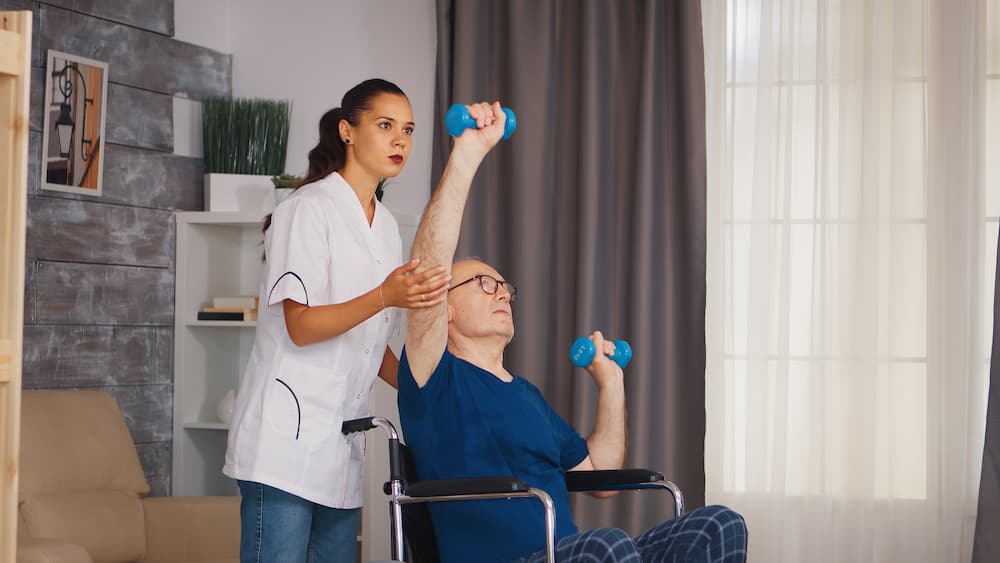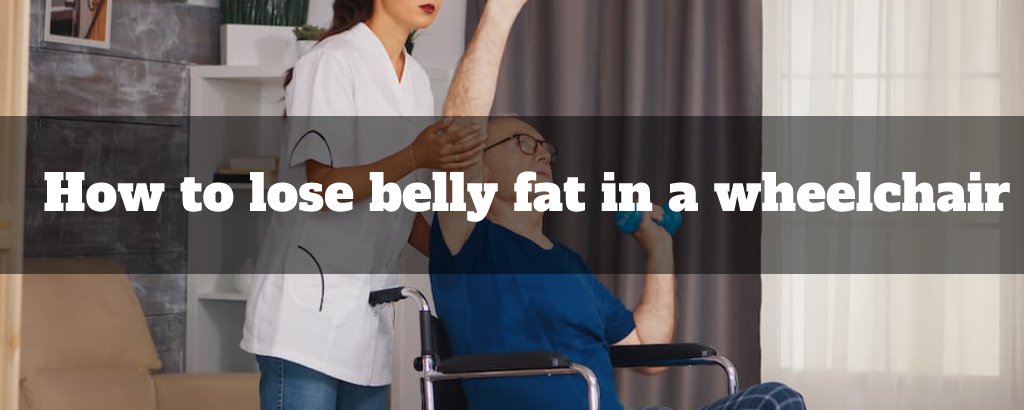Do you want to know how to tone your stomach while in a wheelchair?
Dietary advice typically consists of “eat less, move more.” Some wheelchair-bound individuals have a serious calorie surplus because they don’t get enough exercise. Over time, this will inevitably result in a weight increase.
It is estimated that nearly two-thirds of adults in the United States are overweight or obese.
So, losing fat becomes an essential regimen for them.
This is a particularly challenging task for wheelchair users, but it’s not impossible! says Virali, a woman who lost weight despite being in a wheelchair.
Disability-related obesity is a problem.
When a person’s mobility is restricted, it lessens the range of possible physical activities and, perhaps, dampens their motivation to begin active.
Data from the National Health and Nutrition Examination Survey reveals that people with a disability are 53 % more likely to be overweight (38.5% vs. 25.1%) than people without a disability.
Another report by the CDC says that adults and children who have disabilities have obesity rates that are 58% and 38% higher, respectively, than their non-disabled counterparts.
They Gain Weight Because
Disabled people sometimes have a harder time losing weight than those without a disability. The following are some of the most important causes of this discrepancy:
- In a limited setting, a wheelchair-bound may not be able to exercise. Physical restrictions diminish a person’s activity level, making exercise difficult.
- Poor diet. Wheelchair users may also struggle to estimate their daily calorie needs, leading them to consume more food than they need and ultimately gain weight.
- Certain drugs have the side effect of making people gain weight.
- Lack of understanding of how to maintain a balanced diet.
It can lead to other diseases.
According to research, 78% of people who use wheelchairs are obese.
The 2019 study found that obese people who use wheelchairs are at increased risk of long-term health problems. These diseases included diabetes (92.9%) and cardiovascular disease (90.5%).
How to Lose Weight in a Wheelchair
Despite all this, losing body fat might be intimidating due to these challenges, but it is achievable.
Mike E. King says it is a fundamental change for anyone who has spent significant time in a wheelchair. For me, it was a struggle that required me to carefully plan and stick to new eating habits, simple exercises, and a general way of staying true to the healthy person I wanted to be.
Mark Herbst, a physician, shares his opinion on this. Keep in mind that any quantity of activity is preferable to none. Even 20 minutes three times a week can make a big difference, so if you have access to a wheelchair or a physical therapist, don’t let perfection be the enemy of good. It’s not just one thing, but several little changes leading to a fruitful outcome.
Here are a few methods that have been scientifically proven to lose belly fat.
- Count Calories.
Men need about 2,500 calories daily to stay the same weight, while women need about 2,000.
A wheelchair user may require fewer calories than is suggested.
Paul Clare, a wheelchair bounded woman, says, “Although I do not claim to be an expert, it comes down to consuming fewer calories than you burn.” Each of us consumes calories just by being alive, so we only need to identify our base number and go from there.
A diet of 1,500 calories is a trendy method of fat loss. But individuals’ calorie intake needs differ.
So, if you need help determining how many calories you need to eat in a day to lose weight, talk to your doctor or a registered nutritionist.
- Healthy Eating.
Wheelchair users burn fewer calories via exercise than their non-disabled counterparts, making fat loss and maintenance difficult. As monotonous as it may seem, a healthy diet is necessary.
The formula is to reduce your calorie intake more than your daily expenditure. A balanced diet plan is still needed for wheelchair users who want to lose fat.

But don’t skimp on quality to get the job done faster. Aim for a healthy, well-rounded diet plan that includes:
Starchy food.
One hundred grams of resistant starch per day had a favorable effect on the gut microbiome. In contrast, taking 40 grams daily for four weeks helped reduce harmful bacteria, allowed the body to use glucose better, and cut down on belly fat.
Brown bread, whole grains, and potatoes are good sources, as are fruits and vegetables.
Fiber.
It has been said that eating 30 grams of fiber every day will help you lose weight a lot because it slows down digestion. A 10-gram increase in daily soluble fiber intake reduced belly fat risk by 3.7%
Beans, oats, flax seeds, Brussels sprouts, and asparagus are high-fiber foods that can be used.
Lean protein
Protein is a crucial weight-loss macronutrient. It reduces cravings by 60%, boosts metabolism by 80–100 calories per day, and helps you eat 441 fewer calories per day.
Protein may also reduce stomach fat. A study found that eating more protein helps you lose weight.
Sources such as meat, fish, eggs, and legumes.
Reduce Fats.
Wheelchair-using folks are just as likely to be overweight, hypertensive, or suffer from cardiac issues as any other group of people. Many studies have shown that eating more healthy fats like olive oil can aid in weight loss.
- Keep Sugar Levels Low.
To maintain a healthy weight, it’s best to cut back on or eliminate sugary foods and beverages, as they are linked to weight gain.
Processed foods raise insulin levels, encouraging fat storage in the body. Therefore, eliminate as much sugar as possible from your diet.
Diabetics, hypertensives, and those with any other medical condition should steer clear of high-fat, high-sodium, and high-sugar foods and soft drinks.
- Keep Moving.
Simply changing your diet won’t do anything for your stomach. Exercises are equally important to maintain upper body muscle strength.
Think beyond the box. What else can you do to burn calories if your legs aren’t doing it? They can strengthen their upper body through exercises.

There are a variety of wheelchair workout videos available.
Spot reduction needs to be more realistic. In one study, six weeks of abdominal training did not affect waist circumference or abdominal fat. Thus, only abdominal exercises won’t help.
Aerobic Exercises.
When aiming to lose weight, cardiovascular exercise is important. This kind of thing will pump your blood pressure, make you sweat, and leave you somewhat out of breath.
These simple exercise routines for even the disabled have been found to improve stability, cognitive skills, cardiorespiratory fitness, energy levels, and abdominal muscle strength.
Gymming.
If you fancy gymming, wheelchair users can utilize various gym equipment, including rowing and weight machines, for core muscle workouts.
These exercises mainly focus on upper-body strength training.
Yoga.
Adaptive yoga and other chair-based workouts can help build muscle and are fun.
They are also proven to be efficient in reducing belly fat.
Wheelchair Sports.
Sports such as wheelchair basketball, badminton, and netball are examples of great exercise that may be tried. You may boost your stamina and strength by playing any of these games.
Remember to commit to regular physical activity incorporating cardiovascular and strength training. The benefits it can give you are,
- Stretch out your muscles and improve your flexibility.
- Aids in fat loss.
- Build bone/muscle mass.
- Reduce muscles and joint pain.
- Tone abdominal muscles.
- Boost your energy.
Moderation is the key.
Practice moderation. Eat smaller but frequent meals.
This keeps you from feeling hungry, keeps the hormone ghrelin (hunger-inducing hormone) in check, and helps you avoid the temptation of overeating.
Posture.
One must maintain as much of an upright posture as possible while seated in a wheelchair. Since much of the time is spent sitting, we tend to slouch, causing a bulged belly, also known as a para belly.
This condition typically results from paralyzed or weak abdominal wall muscles.
The research found that men who sat longer were likelier to develop belly fat.
So, keep your posture upright and your belly in check while in a seated position.
Sleep.
A lack of sleep is something that affects all of us. A 2022 research study has shown that getting a good night’s sleep can prevent and even reverse weight gain. It was reported that total abdominal fat area and visceral fat increased by 9% and 11%, respectively, among those who did not get enough sleep.
Bowels.
Most people do not realize that constipation and bloating can make a person’s stomach appear bigger than it is. Make an effort to develop a bowel regimen that works well for you in terms of time and ease. Eat more fiber to make your bowels more consistent.
Breathe Deeply
Wheelchair users often slump when sitting, which lowers their lung capacity and causes shallow breathing. This increases bodily oxygen, which aids fat burning. This can be avoided with deep breathing and cardiovascular exercises.
Hydrate!
Wheelchair users are no exception to the general rule that everyone, including themselves, needs to drink plenty of water. Staying hydrated is essential to maintaining optimal body function and flushing out harmful substances.
A morning glass of water is a great way to kick-start your body’s natural detoxification processes. A glass of water before a meal is also recommended.
Weight loss for people in wheelchairs comes with preparation, patience, and determination.
The only requirements for fitness are your own body and commitment. Start with what you believe is possible, and get as much exercise as possible within your means.
Good luck with your weight reduction journey. Now go live the best life possible! Being in a wheelchair does not prevent one from maintaining physical fitness and doing exercises.

